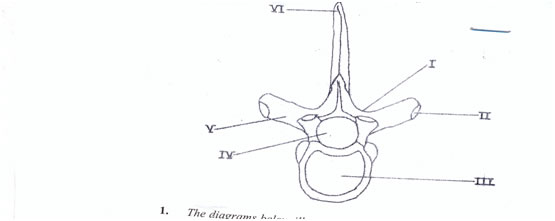This question was attempted by many candidates and their performance was fair. In part (a)(i) candidates could not correctly draw and label thoracic vertebra and in (a) (ii) candidates could not also state function of the labelled part in 1 (a)(i).
In part (b) candidates could not correctly state differences between a cervical vertebra and a thoracic vertebra. In part (c)(i) candidates correctly mentioned major minerals in the bone and in (c) (ii) candidates could not correctly classify the following bones as axial or appendicular skeleton scapula, ribs, claricle and femur geL.
The expected answers were as follows:
DIAGRAM THORACIC VERTEBRA
QUALITY
Size: (8 – 10cm) - 1 mark
Neatness: ruled guidelines ½
drawing lines not broken/wooly ½ - 1 mark
Accuracy: long neural spine 1
large centrum/neural canal 1 - 2 mark
maximum 4 marks
N.B Only correct spelling scored

LABELLING
I - neural arch
II - facet
III - centrum
IV - neural canal
V - transverse process
VI - neural spine
FUNCTIONS OF LABELLED PARTS
FUNCTION OF NEURAL ARCH l
- Form the roof of neural canal
- Protects the neural canal /spinal cord
- Provides points of muscle attachment
FUNCTION OF FACET ll
- for articulation with adjacent vertebra
FUNCTION OFCENTRUM lll
- support / protect the vertebrae
- protect spinal cord
FUNCTION OFNEURAL CANAL
FUNCTION OFTRANSVERSE PROCESS
(b) DIFFERENCES BETWEEN CERVICAL VERTEBRA AND THORACIC VERTEBRA
CERVICAL VERTEBRA THORACIC VERTEBRA
- short neural spine - long neural spine
- vertebraterial canal present - vertebraterial canal is absent
- tubercular facet is absent - tubercular facet is present
- transverse process is branched - transverse process is not branched
- small centrum - large centrum
N.B The points should correlate to score
(c)(i) MAJOR MINERALS IN THE BONE
- phosphorus
- calcium
(ii) CLASSIFICATION
scapula - appendicular
ribs - axial
clavicle - appendicular
femur - appendicular
|



